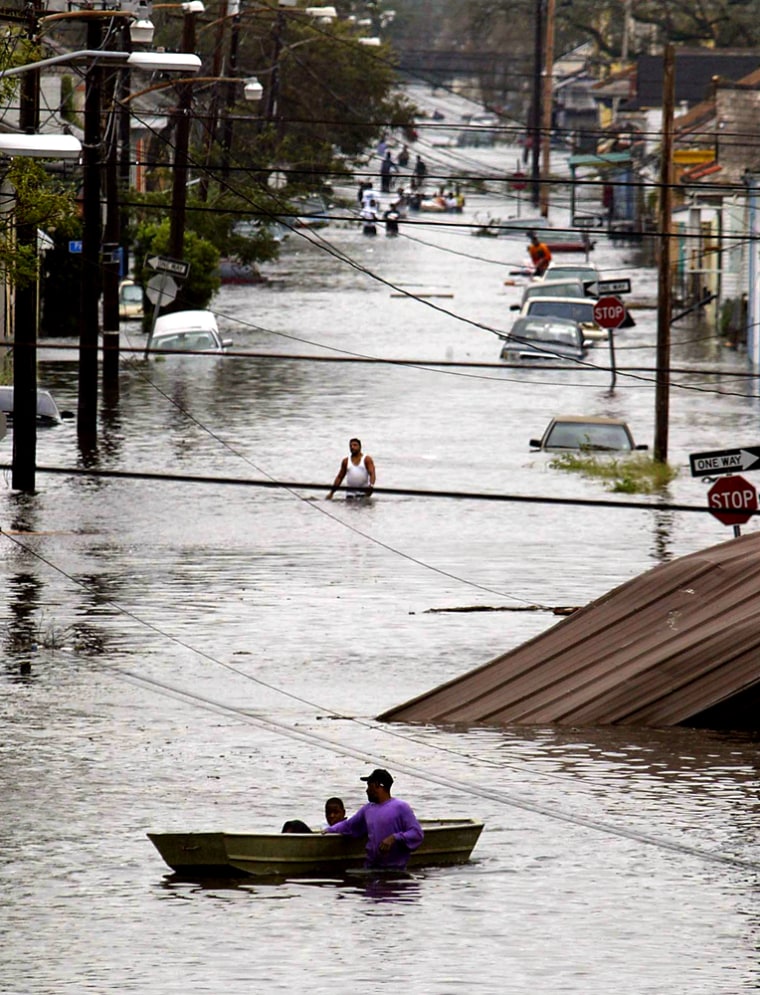Hurricane Katrina devastated swaths of Louisiana, Mississippi and Alabama on Monday, killing dozens. Some estimates put the cost of the storm as high as $26 billion. Oil prices are rising as refineries are shut down. But scientists who study such storms and the way society reacts to them say that more dangerous storms could be on the way, and that they are likely to come more often than many people expect.
The worst hurricanes of the century might cost $100 billion in today's dollars — four times more than the highest estimates for Katrina.
"We haven't seen the worst case scenario by any stretch of the imagination," says Roger Pielke Jr., director of the Center for Science, Technology and Policy Research at the University of Colorado.
The immediate reason is not global warming, although that may have a long-term effect, but a cyclical change in the power and frequency of hurricanes being generated over the Atlantic Ocean. The idea, put forth in a 2001 paper in Science by Stanley Goldenberg of the National Oceanographic and Atmospheric Association (NOAA), is that the Atlantic goes through decades-long stretches where it churns out extra hurricanes — and equally long lulls where the number of hurricanes is low.
The past few decades — when most of the officials learned how to prepare for and cope with hurricanes — have been one big lull. Says John Molinari, a professor at the State University of New York at Albany, "We were way below normal levels for hurricanes in the 1970s, '80s, and '90s." Now he says, it appears that Goldenberg and his colleagues were right, and that the east coast of the United States is in a period of increased hurricane activity that could last 20 years or more.
The costs of such storms could be huge. Pielke, who has made a career of studying how well society responds to hurricanes, says that if the great Miami hurricane of 1926 were to happen today, it would cost $110 billion in modern dollars. (The practice of giving hurricanes human names didn't begin until 1953.) Such costs are not merely determined by the storm's power, but also by where exactly they hit.
Couple that with the increased amount of development along the world's coastlines, and a pattern of insurers retreating from these areas, and you could see a new age of economic disaster brewing (see: Cursing Katrina).
Normal shifts in the climate of the Atlantic Ocean — caused by factors that scientists don't fully understand — are probably the reason that hurricane generation there goes through 20-year periods of frenzy followed by a slowed-down pace that lasts decades more. But there is a possibility that rising global temperatures are helping to create more powerful storms overall.
Kerry Emanuel, a climatologist at the Massachusetts Institute of Technology, assembled data going back 30 years tracking the wind speed of hurricanes and tropical storms (together known as cyclones). Because the best data about the top wind speed for each storm, culled from plane flights through the cyclones, were available only in the western Pacific and the Atlantic, he looked only in those areas. The data seem to show that as the temperature of the oceans rose, so did the duration and power of the storms. Emanuel's results were published in Nature in July.
Some other researchers doubt Emanuel's calculations. But If he's right, there is even more reason to worry about the increasing power of hurricanes pounding into our shores. To make matters worse, hurricane forecasting has a serious weakness, Emanuel says. Right now, even with supercomputers of the kind built by IBM, NEC and Hewlett-Packard aimed at understanding weather, scientists can predict where storms will go, but not how powerful they will be when they hit land.
Pielke, who researches the social response to hurricanes, emphasizes that simple steps, like enforcing a good building code, have been shown to prevent the worst storm damage. Still, often communities don't know if they are set up to deal with a storm until they are an Andrew or a Hugo. Says Pielke: "A little extra vigilance can go an awful long way," says Pielke.
